 |
|
Painted Areas on #5 and #11 Greens...
Steve Wilson, CGCS, Meadowbrook Golf & Country Club, Prairie Village, KS:
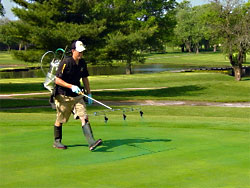
University of Missouri grad student John Haguewood applying Methiozolin to #5 green.
|
 "Many of you have probably noticed (and a few have asked) about the small painted areas on #5 and #11 greens. The area on #5 is in the back right corner of the green and is 400 square feet and the area on #11 is in the back left and is 200 square feet. These paint marking indicate an area where are trying a chemical that is currently in the testing stages but hopes to get EPA registration as a herbicide that will remove poa annua from bentgrass. The active ingredient in the chemical is called Methiozolin. As you know, many of our greens here at Meadowbrook are 50+ years old and have up to 50-60% Poa annua contamination in the original Penncross bentgrass.
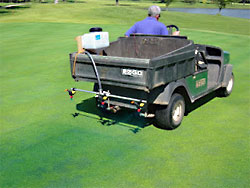
Yours truly making subsequent applicaiton with a sprayer we built.
|
The hope for Methiozolin is that it is capable of very slowly removing Poa annua from bentgrass. 'Very Slowly' is the key for our greens because of our amount of Poa annua on our greens anything short of a very gradual transition would not be pretty and would not be tolerable from a playability standpoint. Recently there have been other new herbicide chemistries come on the market that remove Poa annua from bentgrass, but they all take out the Poa much too quickly and are not an option in our situation.
To date we have made four applications of the Methiozolin at two week intervals, and quite honestly have not really seen any results. Our applications are being overseen by Dr. Xi Xiong, Professor of Turfgrass at the University of Missouri, and her graduate student John Haguewood. From previous experience at the turf farm at the University of Missouri and in other golf course trials, Xi and John expected to see more results so we are looking into possible causes such as the pH of our water source that may be limiting effectiveness of the chemical.
We will likely resume applications in the fall. I will keep you updated as to progress."
Visit Steve's blog at meadowbrookccturfgrass.blogspot.com
|
 |
|
Downshift...
Steve Cook, CGCS MG, Oakland Hills Country Club, Bloomfield Hills, MI:
  "When the temperatures are below 85 degrees, it's easier to push on the acclerator and drive the turf towards the edge. Double cutting greens and rolling them and irrigating less to keep the greens firm and fast doesn't cause too much harm if we pay attention.
But when the temperatures are north of 90 degrees, as in 97 degrees Thursday, it's time to let up on the gas and downshift into a lower gear. That kind of weather is not the time to be a hero and drive over the cliff.
So for the next two days we'll be using good judgment with turf conditions and you might expect to putt greens a little slower than they have been over the past six weeks."
Visit Steve's blog at ohccturf.blogspot.com.
|
 |
|
Vineyard summer...
Matt Crowther, CGCS, Mink Meadows Golf Club, Martha's Vineyard, MA:
 "Whatever you use as a benchmark to call it summer — increased traffic, longer lines, daydreaming pedestrians, first trip to Back Door Donuts, or simply the warm weather that makes you want to go to the beach — IT is here.
Last week we had two days in the 90's. Today was cloudy and cool, then the thunderstorms drifted on past and the sun came out and it turned hot and humid, reaching 86 and a dew point of 69. It all happened in the blink of an eye. Peaceful island, sweater weather and then mayhem and sweltering heat.
"We continue to fight the good fight but at some point only natural rains will make a difference..." |
The course is holding up ok. The greens and tees are performing just as I would like. The fairways and rough are showing signs of a poor irrigation system. Where the coverage is weak the turf is going dormant and even some areas that have sprinklers are going south as the salt water intrusion in our well is wreaking havoc on our soils. Once it dries up like it did in the droughty spring it is impossible to re-wet it.
Some spots in green fairway turf are hard as a rock, other spots just off the tee top are like dust just under the surface. We continue to fight the good fight but at some point only natural rains will make a difference. And once you are dry down deep a thunderstorm does nothing but run off and collect in the low areas."

The Big Guy coming up...
|
Visit Matt's blog at minkmeadows.blogspot.com.
|
 |
|
Perfect weather for dollar spot disease...
Jim Flett, Muskoka Lakes Golf & Country Club, Port Carling, Ontario:
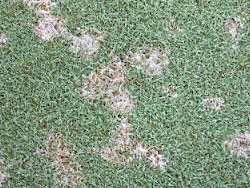  "Yesterday's high got up to 30 degrees Celsius out on the course. We received another 3mm of rain later yesterday afternoon that broke the severe heat dropping temperatures by nearly 10 degrees Celsius down to 21. Last night temps maintained close to 20 falling only to 18.5 by 6am this morning.
This warm, humid weather is ideal for the development of dollar spot disease. While we spray preventatively for this disease on greens, on tees and fairways we employ more of a curative approach. We will continue to monitor the situation and if conditions continue, we may have to apply a curative treatment which is something we seldom have to do.
One of the cultural non-chemical methods to help control this disease is to limit the amount and duration of leaf wetness. Dragging a hose or pole over the turf in the early morning will remove the dew to reduce the duration of leaf wetness.

Fairways dragged with Fairway Snake to remove dew and limit leaf wetness.
|
The FAIRWAY SNAKE is a tool engineered specially for the quick and easy removal of dew from fairways by towing it between two vehicles up a fairway. The Fairway Snake's weighted core and braided shell provide strength and flexibility. The weighted line knocks down the dew, breaks up grass clippings, reduces disease pressure and stands up the turf for a better cut. While the spinning end-unit attachments ensure it's gentle on turf as it quickly and effortless cleans fairways in a single pass.
Other ways of promoting drying of dew are as follows: encouraging air movement by pruning out the lower crowns of trees or thinning stands of trees surrounding greens and along fairways; reducing shade so that early morning sunlight hits the greens; mowing turf in the early morning to displace the dew; or avoiding evening watering during times very conducive to disease spread."
Visit Jim's blog at mlgccgreens.blogspot.com.
|
 |
|
Our greens profile...
Steve Hammon, Traverse City (MI) Golf & Country Club:
 "This is a photo of a soil profile tool laying on 12 green. It shows a cross section of the turf, roots, 22 years of topdressing with sand and the subsoil. Topdressing every three weeks lightly with sand creates a great medium for our roots to grow and to create a smooth well draining surface. Every other year in the spring we use 10 inch deep tines on our greens to aerify the soil and break through the two different layers to encourage rooting. Check out the aerification channels with roots coming out the bottom."
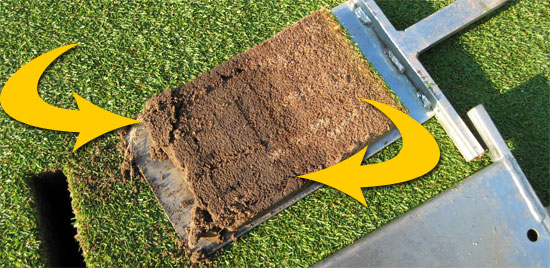
Visit Steve's blog at tcgccgrounds.blogspot.com.
|
 |
|
Waterfall Pumps... Justin Ruiz, CGCS MG, Indian Summer Golf & Country Club, Olympia, WA:
 "Last year the waterfall system only worked for about a week long. This winter we pulled the pumps out of their vaults and were able to get them into a repair shop to obtain an estimate on repair.
The pumps seem to fail every three to four years. The company that I am working with to repair the pumps is going to help me set up a maintenance program for the pumps to extend their operational life. Repairing the pumps every three years is quite a task and relatively expensive.
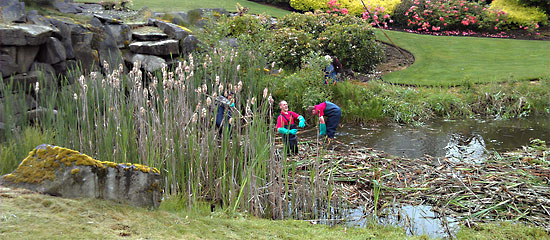
We are now in the process of cleaning up the water feature to enhance our repairs. It is the first time that I have seen the waterfall on #2 work and it is amazing. I can only thank the staff for their hard work pulling cattails and cleaning up the lake so you could see the attraction."
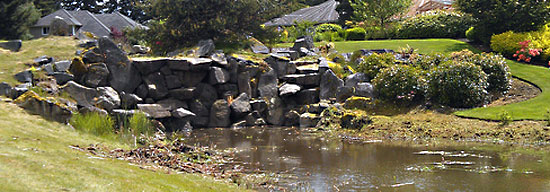
Visit Justin's blog at indiansummergolf.blogspot.com
|
 |
|
There's something to be said...
Jason VanBuskirk, Stow Acres Country Club, Stow, MA:
 "This isn't my first 3-day weekend off in the summer as a superintendent, but there is still that certain level of anxiety that one feels when it's longer than one day off. As my old boss used to say, 'We are control freaks in an uncontrollable environment'. We literally like to control everything, and if you are a heavy technology freak like me, you control EVERYTHING with your iPad. "But, when the day is done, we are still at the mercy of greater powers. We don't get to make those decisions..." |
I control my operating budget, irrigation system, spray logs, employee time off, job board, invoices, project quotes, labor hour tracking, weather data, and I even try to predict future weather forecasts with the 18 different weather apps that I have. But, when the day is done, we are still at the mercy of greater powers. We don't get to make those decisions, even though sometimes we wish we could. It's those times that we let the anxiety-ridden feelings dictate our lives, including taking time off or not taking time off in the summer. This can really mess with work/life balance, even if we never meant it to.
I am in Wells, Maine, right now, camping with my family. Well, we slept in a tent last night, and then moved to a cottage down the street that is actually very nice. It has a little kitchen, air conditioning, and a separate bedroom for our daughter to take a nap in.
"I would be lying if I said that I didn't take my iPad, didn't communicate with my assistant all morning..." |
I would be lying if I said that I didn't take my iPad, didn't communicate with my assistant all morning, and didn't check the irrigation system, labor hour database, and answer emails while my daughter has been sleeping. Yes, I did let anxiety take over me this morning and did some work. But I came to Maine for three reasons:
Number one is quality time with my family. Watching my daughter camp for the first time was incredible! Watching her play in the ocean this afternoon will be even more fun!
Number two is my faith in the greater powers. Even though there are those times that I wish I could take it on my shoulders, I have faith that He will help me out.
Number three is the fact that I have a very trustworthy assistant and very skilled watering team. The plan/program that we have in place at Stow Acres is pretty bullet proof in terms of keeping turf cool. My assistant, Kevin Bracken, has been with me for five years now. He is about as good as they get in the turf industry and I am very fortunate to have him on our team.
I am in Maine a little less anxious because I know he is back home keeping the courses well hydrated! Thanks, Kevin. There's something to be said for a having a top assistant on board!"
Visit Jason's blog at stowacresturf.com.
|
 |
 |
|
About our Blog Aggregator: Many superintendents are now hosting private blogs to better communicate with their golfers and/or members. Beyond local weather and course conditions, there is a great deal of information about projects, methodologies and techniques that would be of value to other superintendents — hence our Turf Blog Aggregator. As every blogger struggles occasionally with content, we also include posts intended to educate golfers about turf maintenance for others to use as a template for their own blogs.
Miss any previous issues of TBA? You can find them all here.
Turf Blog Aggregator(TM) is a trademark of Turnstile Media Group.
|
|